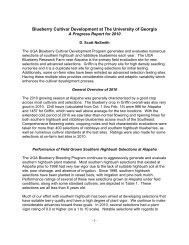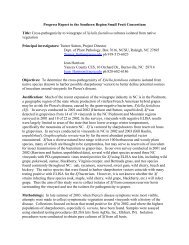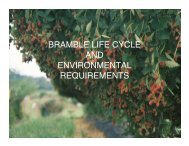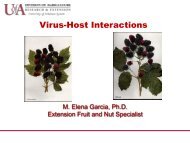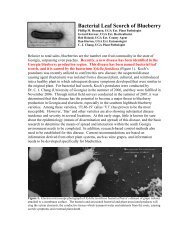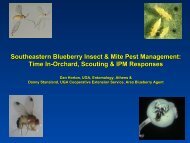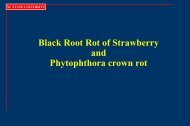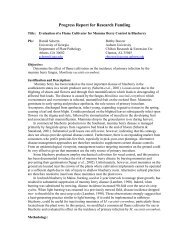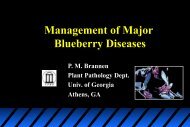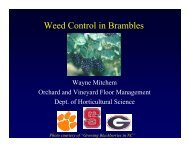Southeast Regional Blueberry Horticulture and Growth Regulator ...
Southeast Regional Blueberry Horticulture and Growth Regulator ...
Southeast Regional Blueberry Horticulture and Growth Regulator ...
You also want an ePaper? Increase the reach of your titles
YUMPU automatically turns print PDFs into web optimized ePapers that Google loves.
14. <strong>Blueberry</strong> fruit set <strong>and</strong> fruit size under natural conditions is determined in large part by number of seeds in the fruit. Low seed counts result insmaller, later ripening fruit. Gibberellic acid can set fruit, but will not fully substitute for total lack of seeds. Fruit set with a combination ofgibberellic acid <strong>and</strong> some seeds develop better fruit size, so bee pollination is important even in fields treated with gibberellic acid. Growers shoulduse honey bees (min. 2 strong hives per acre) if there are not large numbers of honeybees <strong>and</strong> wild bees such as bumble bees <strong>and</strong> southeasternblueberry bees present in the blueberry field. Most large fields do not have enough bees, so honeybees should be imported.15. Although flowers are most receptive to fruit set with gibberellic acid at stage 5 (elongated but not yet open) <strong>and</strong> 6 (open), seedless fruit set justwith gibberellic acid are smaller in size than partially seeded fruit set with the help of gibberellic acid. Allow at least 40 to 50% of the flowers toopen <strong>and</strong> be worked by bees before gibberellic acid application. About 10% of the petals (corollas) should have fallen. Apply a second application ofgibberellic acid 10 to 18 days later.1 = no visible swelling, bud scales completely enclose the flowers;2 = visible swelling of bud, scales separating, flowers still completely enclosed;3 = bud scales separated, apices of flowers visible;4 = individual flowers distinguishable, bud scales abscised;5 = individual flowers distinctly separated, corollas elongated but closed;6 = corollas completely exp<strong>and</strong>ed <strong>and</strong> open;7 = corollas dropped. Adapted from J. M. Spiers, 1978, J. Amer. Soc. Hort. Sci. 103 (4): 452-454.Fig. 1. Stages of flower bud development in rabbiteye blueberries:Gibberellic acid as an Aid for Fruit Set of Rabbiteye Blueberries Following Slight Freeze InjuryResponse: Increase fruit set of flowers with slight freeze damage.Material: Gibberellic acid -- ProGibb 4% liquid concentrate or GibGro 4 LSSituations <strong>and</strong> timing: The use of gibberellic acid for fruit set following freeze damage to rabbiteye blueberries is a fairly recent discovery. Field<strong>and</strong> laboratory experiments indicate it may be used in several situations. Actual damage suffered during a freeze depends on many factors





